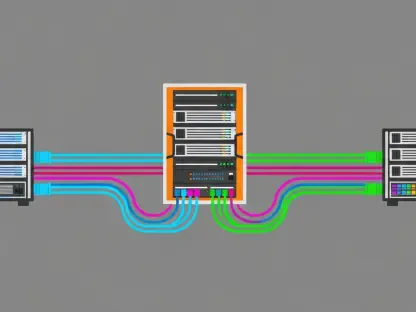The transformative power of cloud computing is revolutionizing the way businesses operate, offering unprecedented scalability, flexibility, and efficiency. However, this evolution is not without its challenges. As companies increasingly leverage cloud applications for critical data management, such as through platforms like Salesforce or Microsoft 365, they are exposed to heightened risks. Data breaches, losses, and issues of regulatory noncompliance have surged, prompting a vital question: is the current cloud data protection strategy robust enough? Achieving effective data security in the cloud requires more than just technology; it demands a holistic approach that encompasses policy, process, and cultural adaptation. Understanding these multifaceted challenges and corresponding strategies forms the backbone of developing strong cloud data protection frameworks.
The Rapid Adoption of Cloud Technologies
The ongoing proliferation of cloud technologies signifies a fundamental shift in enterprise operations, with cloud applications becoming essential tools. Salesforce, Microsoft 365, and a host of other bespoke solutions continue to see significant growth as businesses move their functions into the digital realm. According to industry forecasts, global spending on public cloud services is projected to rise by a striking 20.4%. This staggering growth highlights the myriad benefits of cloud computing, such as improved business agility and competitive advantage. Yet, these benefits come with increased exposure to vulnerabilities and potential exploitation as enterprises integrate cloud systems into their infrastructure. With promising opportunities for innovation, companies must remain vigilant to guard against the distinct set of challenges that accompany this digital migration.
Cloud computing offers significant advantages, but it also requires enterprises to rethink existing security measures and forge new pathways to protection. As businesses continue to embed cloud solutions into their operations, a more profound understanding of the nuanced risks involved becomes essential. A deeper exploration of these emerging vulnerabilities is crucial for safeguarding valuable data assets and ensuring operational continuity. Consequently, these newer, more insidious threats must be met with proactively designed defense strategies. Cultivating an organizational culture that emphasizes cloud security is a pivotal step toward building resilient infrastructures and mitigating potential risks effectively.
Emerging Risks in Cloud Data Environments
As enterprises expand their cloud infrastructure, the exposure to data vulnerabilities grows more complex and disconcerting. A recent analysis, as reported in the 2023 Verizon Data Breach Investigations Report, underscores that a significant proportion of breaches involve cloud assets. The increased focus of malicious entities on exploiting cloud environment weaknesses signifies an urgent requirement for fortified defense mechanisms. Inevitable challenges arise from the shared responsibility model, where cloud service providers are tasked with securing infrastructure, but enterprises hold accountability for data usage and access authorization. This dynamic intricately complicates protection strategies, necessitating a comprehensive understanding of unique organizational responsibilities and mitigating potential risks effectively.
Attackers have recognized the strategic value in targeting cloud-based data systems, leading to refined and targeted attempts to exploit vulnerabilities. The intricacies of the shared responsibility model require enterprises to adopt vigilant oversight of data operations and preventive security measures. Organizations need to reassess their existing protection protocols to address the evolving threat landscape. As cloud computing scales rapidly, businesses must deploy more sophisticated tools and strategies to detect threats early and ensure robust cloud data security. This includes collaboratively working with service providers to navigate these complexities and deploying innovative solutions tailored to unique organizational needs.
Addressing Key Threats to Cloud Data
Cloud environments introduce manifold challenges in the form of misconfigurations, insider threats, and third-party risks. These vulnerabilities represent significant dangers to data integrity and continuity. Misconfigurations, errors in cloud storage or access settings, can lead to devastating data breaches. Industry projections anticipate that a significant portion of cloud security failures will be attributable to inadvertent misconfigurations instituted by customers. Enterprises must prioritize the proactive resolution of these issues to minimize exposure to potential data leaks effectively. Complementing these efforts, instituting stringent backup procedures is vital. A prevalent misconception persists regarding SaaS providers’ backup capabilities. Businesses operating in cloud environments must independently ensure regular, comprehensive data backups, fortifying defenses against data loss and corruption.
Insiders and third-party collaborators often possess broad access privileges within cloud infrastructures, increasing risk. This conferment of privileges, while essential for collaborative efforts, entails increased vulnerabilities. Implementing stringent access controls and security measures is imperative to mitigate the risk of unauthorized data access or leaks. Emphasis should be placed on educating staff and partners on security best practices to effectively minimize exposure to these risks. Strategic initiatives aimed at embedding a culture of security consciousness within teams and augmenting existing protection processes can collectively bolster efforts to safeguard data assets. By recognizing these key threats and addressing them decisively, businesses can create more resilient cloud data environments equipped to navigate an intricate cyber landscape.
Regulatory Challenges and Compliance Pressures
In the rapidly evolving world of cloud computing, adhering to regulatory standards like GDPR, HIPAA, and CCPA has become increasingly imperative for enterprises dealing with data proliferation. These regulations compel businesses to diligently manage and protect their data while maintaining detailed, auditable records to demonstrate compliance. Failure to meet stringent requirements can result in substantial financial penalties and reputational damage, underscoring the critical need for lawful data handling practices. With cloud data continuing to expand, managing sensitive information amidst diverse legal landscapes presents challenges to ensuring regulatory compliance effectively. Enterprises must therefore implement structured frameworks and advanced tools to proactively address regulatory pressures and maintain compliance.
A thorough evaluation of organization practices and integration of robust protocols is necessary for lawful data management in the cloud. Compliance demands not only technology-focused solutions but also organizational transformation, touching on policy, process, and cultural spheres. Building audit-ready systems and implementing sophisticated oversight mechanisms can enhance risk management and regulatory adherence efforts. Developing comprehensive strategies that address regulatory compliance challenges head-on will markedly improve enterprise data protection processes. Enterprises can leverage advanced analytics within cloud platforms to ensure complete visibility into operations, stemming from a unified approach towards compliance. This holistic pursuit will support enterprises in navigating an evolving regulatory environment, minimizing risks, and optimizing cloud data security.
Strategies for Effective Cloud Data Protection
Creating an effective cloud data protection strategy requires a multifaceted approach, beginning with detailed inventorying and classification of data assets. Accurate documentation of data storage, processing, and movement across cloud environments forms the foundation of robust security measures. Data Loss Prevention (DLP) tools and Cloud Access Security Broker (CASB) platforms enable efficient classification and unimpeded monitoring of cloud resources. These advanced solutions empower enterprises to enhance visibility into operations, track potential vulnerabilities, and implement responsive protection measures, thus optimizing cloud data security posture. Coupling technology efforts with informed identity and access management (IAM) processes significantly increases data security.
IAM processes encompass principles such as least privilege and zero trust, promoting limited access to critical data through stringent authorization procedures. Employing multi-factor authentication, just-in-time access protocols, and role-based access controls contribute to safeguarding cloud data from unauthorized intrusion or manipulation. Enhancing oversight mechanisms, alongside promoting a culture that emphasizes stringent security practices, can fortify enterprise resilience against prevalent threats. These proactive strategies foster an organization’s capacity to mitigate risks and effectively protect sensitive assets. By leveraging tailored data protection frameworks and harnessing advanced technology tools, businesses can position themselves at the forefront of cloud data security efforts.
Technical Solutions and Automation
Implementing technical solutions, particularly encryption, plays a pivotal role in safeguarding data across all states—whether at rest, in transit, or in use. While cloud services do offer certain encryption capabilities, managing encryption keys internally is critical to maintaining the integrity of sensitive data and operational continuity. Hardware-based security solutions may be necessary to provide enhanced protection for workloads involving extremely sensitive information. Furthermore, enterprises must prioritize automated configuration management to minimize human error and ensure adherence to sophisticated security protocols and policies. Automation aids in standardizing cloud resource configurations, reducing exposure to threats, and optimizing protection strategies.
Ensuring robust protection in cloud environments involves employing advanced monitoring and detection systems such as Security Information and Event Management (SIEM) solutions. SIEM integration drives superior logging capabilities and aids in identifying vulnerabilities early, enabling rapid responses to potential intrusions. By utilizing behavioral analytics and threat intelligence to support security endeavors, organizations can enhance their security posture, mitigating risks effectively. These advanced technologies, through their comprehensive approach, empower organizations to bolster cloud data protection actively. Such initiatives should form part of cohesive and integrated efforts tailored to the specific operational needs of the enterprise, ensuring effective deterrent mechanisms are actively in place.
Cultivating a Security-Conscious Culture
The surge in cloud technologies signifies a deep transformation in enterprise operations, with cloud applications becoming indispensable tools. Platforms like Salesforce, Microsoft 365, and other tailored solutions continue experiencing substantial growth as firms digitalize operations. Industry forecasts indicate global spending on public cloud services is expected to increase by an impressive 20.4%. This surge underscores the numerous advantages of cloud computing, including enhanced business agility and competitive edge. However, these benefits also bring increased exposure to vulnerabilities and potential exploitation as enterprises integrate cloud systems into their infrastructures. Amid promising opportunities for innovation, companies must stay alert to tackle the unique challenges accompanying this digital transition. Cloud computing offers substantial benefits but requires enterprises to reevaluate security measures and craft new defense strategies. As businesses increasingly adopt cloud solutions, understanding nuanced risks is crucial for safeguarding data assets. Building a culture emphasizing cloud security is essential for resilient infrastructures, mitigating risks effectively.









